 Background Knowledge
Background Knowledge
Internet of Things (IoT) is an information carrier based on the Internet and traditional telecommunications networks, allowing all independently addressable physical objects to form an interconnected network. This technology enables the connection of two or more interconnected devices to send and receive information over the Internet. Essentially, it is still the Internet, but the terminals are no longer computers (PCs, servers), but embedded computer systems and accompanying sensors. With the development of computer network technology, computers serving humanity have integrated into our lives in various forms, such as wearable devices, environmental monitoring devices, virtual reality devices, etc. In summary, as long as there is hardware or products connected to the Internet and data interaction occurs, it is called IoT.
Massive IoT describes a network with a large number of connected devices. The significant differences from other types of IoT are reflected in data volume, latency, energy consumption, and processing capability. Devices in massive IoT collect data and send information back to a central server/cloud. For IoT devices in remote locations, these “things” are generally low-cost, low-power, and relatively “dumb.” For example, agricultural sensors used to collect information in fields, rivers, and forests.
Military IoT (IoMT) can enhance situational awareness for frontline deployed troops, track the movement of goods globally, and provide vital signs of injured personnel to emergency responders. Driven by space technology, IoMT can unify networks, providing incredible beyond-line-of-sight capabilities for combat personnel even in the most severe and contentious environments.
 1. Hierarchy of IoT
1. Hierarchy of IoT
According to the four processes of information generation, transmission, processing, and application, IoT can be divided into four levels: perception layer, connection layer, management layer, and application layer.
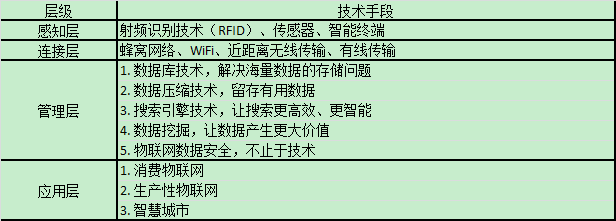
With the surge in the number of applications, IoT has shown characteristics of diversification, scaling, and industrialization. The various layers of IoT are both independent and closely linked. At the perception, connection, and management layers, different technologies at the same level complement each other to suit different environments; for different levels, various configurations and combinations of technologies are provided based on application needs, forming a complete technical solution. The choice of technology is guided by specific applications, selecting appropriate sensing technologies, networking technologies, and data information technologies based on specific task requirements and environments.
 2. Key Technologies of Massive IoTCurrently, massive IoT is in a period of rapid growth, largely due to advancements in cellular networks. In terms of connection numbers, Juniper Networks estimates that by 2024, the total number of IoT connections will grow from 35 billion in 2020 to 83 billion. Half of these connections may be massive IoT. In terms of value, Industry ARC predicts that by 2026, the compound annual growth rate (CAGR) of massive IoT will grow by 7.1%, reaching $121.4 billion. The specific key technologies include the following.NO.1Radio Frequency Identification Technology
2. Key Technologies of Massive IoTCurrently, massive IoT is in a period of rapid growth, largely due to advancements in cellular networks. In terms of connection numbers, Juniper Networks estimates that by 2024, the total number of IoT connections will grow from 35 billion in 2020 to 83 billion. Half of these connections may be massive IoT. In terms of value, Industry ARC predicts that by 2026, the compound annual growth rate (CAGR) of massive IoT will grow by 7.1%, reaching $121.4 billion. The specific key technologies include the following.NO.1Radio Frequency Identification Technology
Radio Frequency Identification (RFID) technology is a non-contact automatic identification technology that identifies target objects and obtains relevant data through radio frequency signals.
Its main components include read-write tags, readers, and antennas. The electronic tag chip has a data memory that can store identification information of the items to be identified; the reader sends electronic signals through the antenna, and the tag emits the stored identification information after receiving the signal, which the reader then receives and identifies, finally sending the recognition result to the host.
RFID technology has a wide range of applications, such as library magnetic cards, access control systems, and barcodes on medicines and food.
NO.2Cellular Networks
The main driving force behind massive IoT is the advancement of cellular communication, as any massive IoT relies on reliable low-power wide-area network (LP-WAN) technology. A “good” LP-WAN has the following characteristics:
1. Wide coverage: able to economically and efficiently connect a large number of devices over long distances;
2. Low power consumption: connects and manages devices over a long lifecycle;
3. High security: ensures that users can be confident that devices and data will not be intercepted by malicious actors.
Clearly, Wi-Fi, Bluetooth, and other “short-range” protocols cannot meet these requirements. Therefore, cellular networks with very wide coverage become particularly important.
NO.3LTE-M and NB-IoT Technologies
In the 2010s, 3GPP (the organization responsible for developing specifications for third-generation mobile communication systems and subsequent evolution technologies) recognized the need to support low-maintenance, low-power Internet of Things devices. In 2016, 3GPP confirmed two new network technologies: Machine Type Communication (LTE-M) and Narrowband IoT (NB-IoT). The differences between these two standards are significant.
LTE-M, also known as LTE Cat M1, uses the same spectrum and base stations as 4G/LTE, supporting downlink and uplink technologies of up to 1 Mbps, with a latency of 50-100 milliseconds, making it very suitable for real-time communication. LTE-M has been widely deployed in existing LTE networks. According to the Global System for Mobile Communications Association (GSMA), as of May 2022, 60 operators have provided LTE-M services.
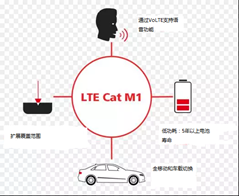
Technical advantages of LTE-M
(supports voice functionality through VoLTE, low power consumption, full mobility and vehicular handover, extended coverage)
However, for some users, having NB-IoT (also known as LTE Cat M2) is sufficient. According to GSMA, as of May 2022, 110 operators have launched NB-IoT networks. NB-IoT uses simpler chips and has lower power consumption. It supports a maximum rate of 62.5 kbps and a latency of 1.5-10 seconds. Clearly, it is not suitable for real-time communication, but it is adequate for intermittent data transmission. Therefore, NB-IoT sensors can support battery life of up to 10 years.
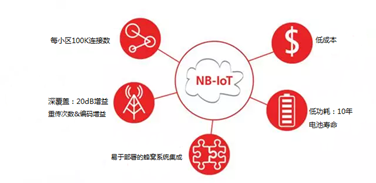
Technical advantages of NB-IoT
The table below compares key data between LTE CAT-M1 and NB-IoT.
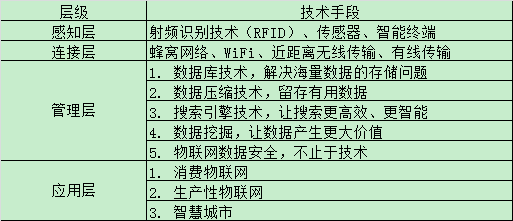
NO.45G Technology
Currently, we are entering the 5G era. It is clear that the ultra-high speed and low latency characteristics of 5G will accelerate the deployment of massive IoT.
3GPP has agreed to incorporate NB-IoT and LTE-M technologies into 5G specifications. NB-IoT and LTE-M will coexist with other 5G components in the same network, such as enhanced mobile broadband and critical communications. This means that mobile operators’ investments are protected, and NB-IoT and LTE-M modules will withstand the test of the future.
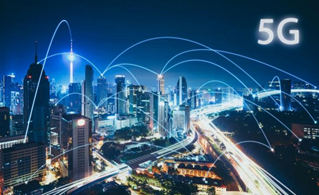
In the 5G era, NB-IoT and LTE-M networks will be more widespread than ever and will support more devices. This is thanks to the unprecedented capacity of 5G, which has the following features:
1. Up to 100 times the number of devices connected per unit area compared to 4G LTE;
2. Supports 1 million devices per 0.386 square miles or 1 square kilometer;
3. 99.999% availability;
4. 100% coverage;
5. Network energy consumption reduced by 90%, meaning connected objects can operate for months or years without human assistance;
6. Battery life of low-power IoT devices can last up to 10 years;NO.5New SIM Cards for New Connected Devices
Without changing SIM technology, massive IoT would not be possible. The plastic SIM cards familiar to smartphone users are not suitable for the IoT world—they are too complex to be inserted into millions of small machines and not robust enough to withstand extreme temperatures, humidity, and vibrations. To meet these conditions, dedicated eSIMs have been developed. They can be soldered in place and remotely activated throughout the device’s lifecycle. eSIM technology is currently being improved. They are now more compact, such as the ultra-small MFFXS designed by Thales, suitable for space-constrained situations.
Another new type of SIM card is iSIM (integrated form of eSIM), which is planned to be launched in 2023. It has already been certified by GSMA, the Trusted Connectivity Alliance, and the European Telecommunications Standards Institute. In the system-on-chip (SoC) of the device, iSIM is embedded in a tamper-proof element. It no longer relies on discrete SIM card hardware and can be wirelessly activated using industry security protocols. Its area is less than 1 square millimeter.
GSMA believes that the new SIM card form factor will accelerate the rollout of massive IoT. Their research found that 83% of enterprises consider eSIM crucial for the success of their IoT deployments. The startup Kaleido predicts that by 2027, over 630 million devices will be compatible with iSIM, accounting for 19% of all eSIM shipments.
 3. Application Scenarios of Massive IoT
3. Application Scenarios of Massive IoT
As 5G continues to spread globally, it will provide opportunities for thousands of businesses to undergo digital transformation. By turning “silent” machines into intelligent nodes on smart networks, businesses will save costs, improve efficiency, and create new revenue streams.Massive IoT can be applied in the following scenarios.
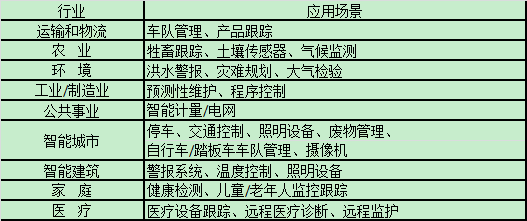
 4. Military IoT Changing Military OperationsIoMT is a way to connect traditional independent networks. It gathers and analyzes data from global and space sensors, then provides this data to operators and commanders in the context of the operational environment, allowing them to decide on the next steps.Below are four military use cases of IoMT on the interconnected battlefield.NO.1Frontline AR Technology
4. Military IoT Changing Military OperationsIoMT is a way to connect traditional independent networks. It gathers and analyzes data from global and space sensors, then provides this data to operators and commanders in the context of the operational environment, allowing them to decide on the next steps.Below are four military use cases of IoMT on the interconnected battlefield.NO.1Frontline AR Technology
“Pokémon GO,” as a sensational game, is one of the first popular applications of augmented reality (AR), allowing millions of people worldwide to use smartphone cameras and AR overlays to find items in their physical environment.
For the military, AR headsets currently in development can project important information. This way, soldiers can see real-time information about terrain, weather conditions, etc., and quickly distinguish between friend and foe.
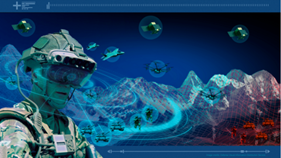
NO.2Smart Bases, Logistics, and Troop Protection
Whether in peacetime or wartime, supporting and maintaining operations often involves manual inventory and transportation tracking to ensure timely replenishment or coordination of critical supplies or activities. With the U.S. military’s focus on the Indo-Pacific theater, these logistical challenges will multiply.
Similar to commercial companies using RFID or other smart tracking devices, military logistics experts will benefit from real-time views of inventory and supplies in motion and use game-changing data analytics techniques to better predict and respond to challenges.
Similarly, the U.S. Department of Defense has thousands of miles of base perimeters to defend against threats. Increasing the number of network sensors detecting movement or activity along the perimeter can provide earlier warnings to troop protection teams of potential dangers, allowing them to respond more quickly and effectively. Smart bases will be able to leverage these commercial technologies in a super-secure manner, optimizing logistics and planning across the entire base using space-based IoT.
NO.3Enhanced Telemedicine Capabilities
The conflicts in Iraq and Afghanistan changed the way care is provided to combat casualties, improving survival rates and establishing new standards for medical evacuation within the critical “golden hour” of trauma care. Joint forces can leverage telemedicine technology to further improve survival rates, connecting battlefield medics directly with military health systems that can provide experts, medical records, and more resources.
IoMT can monitor the vital signs of special forces personnel during critical “golden hour” situations, accelerating medical care, linking on-site medical personnel with life-saving medical information, prioritizing medical resources for faster care, and thus achieving better medical outcomes.
Improvements in space connectivity and increasingly mature telemedicine technologies will further enhance the capabilities of battlefield medics under harsh conditions. Battlefield medics will have direct access to highly skilled health experts worldwide. Exchanging patient health records and vital signs can prepare incoming medical evacuation teams and field hospitals in advance.
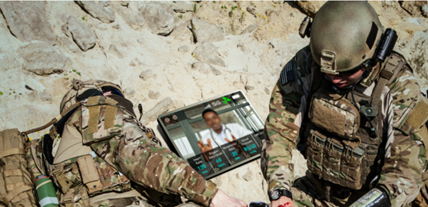
NO.9“Joint Attack” Munitions
As adversaries become increasingly intelligent and targets become faster and more mobile, weapon systems designed to counter these threats need to be flexible enough to adapt to sudden changes in targets and dynamic mission requirements.
Space-based communication networks will assist “joint attack” munitions, enabling the U.S. and its allies to maintain an advantage over complex adversaries, with the ability to reprogram in-flight to respond to sudden changes in battlefield targets. Gunners applying “joint attack” munitions can use space-based devices to reprogram or reassign tasks to munitions in-flight. Munitions can change strike targets based on mission needs.
 5. Conclusion
5. Conclusion
IoT technology is not a brand new invention but an integration of the Internet, sensing technology, artificial intelligence, and other technologies. With IoT, people can connect devices and issue commands, as well as analyze data and plan actions, thus having enormous development potential and a wide range of application scenarios.
END
Compiled by: Jiang Song
Verified by: Huang Jin
Edited by: Hu Zhiqiang, Jiang Song
Reviewed by: Zhang Yisheng
Corporate Mission: Enhance national defense with electronic equipment and serve society with technology industry
Corporate Vision: Build an innovative high-tech group that is domestically leading and internationally advanced in the field of information systems and intelligent equipment
Core Values: People-oriented, Responsibility, Teamwork, Progress
